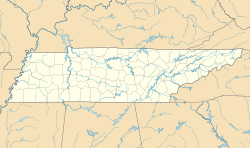Airdrie (Nashville, Tennessee) facts for kids
Quick facts for kids |
|
|
Airdrie
|
|
| Location | 3210 Avenal Avenue, Nashville, Tennessee, U.S. |
|---|---|
| Area | 2.8 acres (1.1 ha) |
| Built | c.1797-c. 1805; c. 1910 |
| Architect | George Norton |
| Architectural style | Neoclassical |
| NRHP reference No. | 05001027 |
| Added to NRHP | September 15, 2005 |
Airdrie, also known as Petway House or the Buell-King House, is a historic home in Nashville, Tennessee, USA. It began as a log house built between 1797 and 1808. In the past, it was a large farm where enslaved people were forced to work before the American Civil War. After the war, it became home to soldiers who fought for the Union (the North).
Contents
Where is Airdrie?
Airdrie is located at 3210 Avenal Avenue in South-East Nashville, Tennessee. Nashville is the main city in Davidson County, Tennessee.
Airdrie's Story: From Log House to Grand Home
Early Days and First Owners (1797-1825)
The land where Airdrie stands was first owned by John Foreman. In 1797, William Coldwell bought the land. He started building a two-story log house that year, finishing it around 1808. The property also had a small log cabin and a horse barn.
In 1808, Coldwell sold the house to William Dickson. He was a Congressman, meaning he was a member of the United States House of Representatives. Later, in 1817, another Congressman named Thomas Claiborne bought the house. However, he sold it in 1818 to Gilbert Gray Washington, who was a Justice on the Tennessee Supreme Court.
The Petway Family and Enslaved Labor (1825-1866)
In 1825, Hinchey Petway bought the house. He was a successful merchant from Franklin, Tennessee. Today, a historic area in Franklin called Hincheyville is named after him. Petway bought more land, making the property 431 acres. He owned African people who were enslaved and forced to work on this large farm, which was then called a Southern plantation.
Hinchey Petway lived there with his wife, Susanna, and their seven children. When he passed away in 1856, the house was left to his wife and children. The Petway family continued to own the house through the American Civil War.
Union Veterans and Neoclassical Redesign (1866-1950s)
After the Civil War, in 1866-1867, Judge John S. Brien bought the house. When he died in 1867, his wife, Rochie Howard Brien, inherited it. She lived there until she passed away in 1930. She shared the house with her daughter, Rochie, and her son-in-law, George P. Buell. George Buell was a Union Colonel, meaning he was a high-ranking officer who fought for the North in the Civil War. He became the owner of the house.
Around 1910, Colonel Buell hired an architect named George Norton. Norton redesigned the house in the Neoclassical style. This style often uses ideas from ancient Greek and Roman buildings. Norton added wooden siding, a front porch, and a grand staircase inside the house. George Norton's sister, Ruth, married Colonel Buell's grandson, Don Carlos Buell II. They lived in the house until the 1950s.
Later Owners and Renovations (1953-Present)
In 1953, Ward Allen, an English Professor at Vanderbilt University, bought the house. He and his wife, Peggy, lived there until 1958. They sold it to Charles and Josephine Toney. In 1963, R. Harold King and his wife, Dorothy, bought the house. The Kings made many improvements and updates to the home.
Why Airdrie is Important
Airdrie is important because of its history and its beautiful design. It has been listed on the National Register of Historic Places since September 15, 2005. This means it is recognized as a special place that should be protected.



